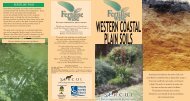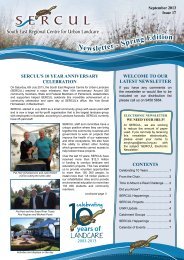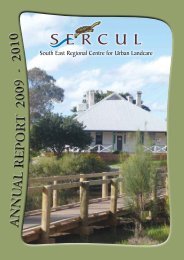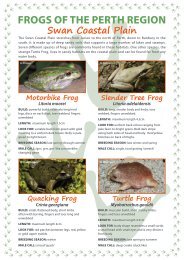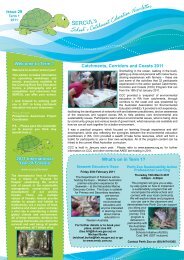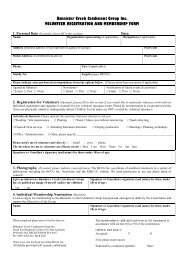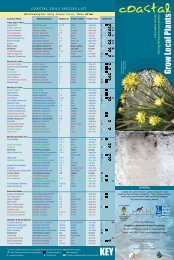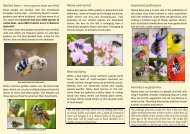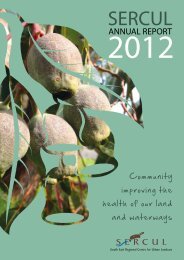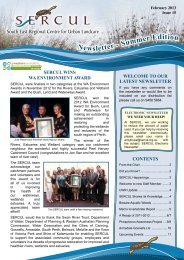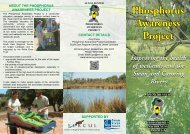Anstey – Keane - SERCUL
Anstey – Keane - SERCUL
Anstey – Keane - SERCUL
Create successful ePaper yourself
Turn your PDF publications into a flip-book with our unique Google optimized e-Paper software.
An area’s biological importance is<br />
not always immediately apparent.<br />
This is certainly the case at <strong>Anstey</strong>-<br />
<strong>Keane</strong> dampland—a small parcel of<br />
uncleared land in the heart of semirural<br />
and semi-urban Forrestdale. This<br />
is not a jarrah forest with its leafy<br />
canopy, nor a karri forest with its<br />
stately giants. Yet this patch of bush<br />
harbours a remarkable diversity of<br />
plant species amid an ever-encroaching<br />
urban environment.<br />
Dampland, heathland and<br />
wetland<br />
Many of the flora species in the<br />
<strong>Anstey</strong>-<strong>Keane</strong> area are found in lower<br />
and wetter land known as ‘dampland’.<br />
Here, moisture is diffused through<br />
the land and not usually visible on<br />
the surface. The wetness of the land<br />
is usually inferred only from the types<br />
<strong>Anstey</strong>-<strong>Keane</strong><br />
dampland<br />
Armadale<br />
of plants it supports. Dampland is<br />
thus unlike other wetlands, such as<br />
the nearby internationally significant<br />
Forrestdale Lake with its large body<br />
of open shallow water in winter and<br />
spring that usually dries out in summer.<br />
Damplands are moist basins covered<br />
with plants. The types of plants found<br />
in damplands depend on moisture<br />
close to the surface of the land. As<br />
many of these plants are short and<br />
ground-hugging, the area is often<br />
called heathland, though there are also<br />
sedgelands and herblands in the area.<br />
Before European settlement, these<br />
once floristically rich damplands<br />
occurred from Pinjarra to the southern<br />
Perth metropolitan area. The sandy,<br />
clay soils of these flat damplands called<br />
the Pinjarra Plain have resulted in the<br />
evolution of their unique vegetation<br />
Previous page<br />
Main <strong>Anstey</strong>-<strong>Keane</strong> dampland.<br />
Inset Green kangaroo paw.<br />
Left Purple flag is common in the reserve.<br />
Below Starflower.<br />
Photos <strong>–</strong> Sallyanne Cousans<br />
over thousands of years. The northernmost<br />
tip of the Pinjarra Plain is<br />
wedged between the Bassendean Dune<br />
complex to the west and the Wungong<br />
River to the east. Confined almost<br />
solely to the east side of the Swan<br />
Coastal Plain, the Pinjarra Plain was<br />
highly suitable as good agricultural<br />
land and so has been almost entirely<br />
cleared. With the removal of almost<br />
all the native vegetation for farming,<br />
the only places it can be found today<br />
are along the Perth<strong>–</strong>Bunbury railway<br />
line, road verges (such as Mundijong<br />
Road), nature reserves, remnants on<br />
private property, and two large areas in<br />
Forrestdale, including the east side of<br />
Forrestdale Lake Nature Reserve and<br />
the <strong>Anstey</strong>-<strong>Keane</strong> damplands.<br />
<strong>Anstey</strong>-<strong>Keane</strong><br />
The <strong>Anstey</strong>-<strong>Keane</strong> dampland is<br />
made up of three parcels of land:<br />
one vested in the Western Australian<br />
Planning Commission and part of<br />
Jandakot Regional Park; another vested<br />
in Landcorp (Western Australian Land<br />
Authority) and not part of the regional<br />
park; and a third parcel of two lots in<br />
private hands. None of this area is vested<br />
in the Conservation Commission of<br />
Western Australia.<br />
From <strong>Anstey</strong> Road, the dampland is<br />
flat and the vegetation is low. It stretches<br />
from Armadale Road in the south to<br />
Ranford Road to the north. The land<br />
is flat with barely a rise or fall. The<br />
trees are short and the bushes and other<br />
vegetation are low. One nearby resident<br />
calls the area “scrub”, implying that its<br />
vegetation is low, ugly and worthless—<br />
fit only for clearing for roads and<br />
housing. Much of its vegetation is small<br />
and exquisite, but intrinsically valuable<br />
in its own right.




